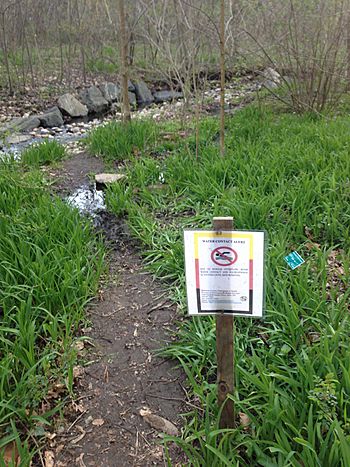Towson Run facts for kids
Quick facts for kids Towson Run |
|
|---|---|

A portion of Towson Run meanders into Glen Woods on the campus of Towson University.
|
|
| Country | United States |
| State | Maryland |
| County | Baltimore County |
| Physical characteristics | |
| Main source | Baltimore County, Maryland, United States |
| River mouth | Baltimore County, Maryland, United States 39°23′22″N 76°38′35″W / 39.38936°N 76.64299°W |
Towson Run is a small stream in Baltimore County, Maryland, in the United States. It is a tributary of Jones Falls, which means it's a smaller stream that flows into the larger Jones Falls river.
This stream flows north through several important places. You can find it running through the grounds of Sheppard Pratt and the campus of Towson University. It also flows near the neighborhoods of Rodgers Forge and Armagh Village.
Contents
What is Towson Run?
Towson Run is a natural waterway that plays a role in the local environment. It helps carry water from rain and other sources into the larger river system. Streams like Towson Run are important for the plants and animals that live nearby.
Where Does Towson Run Start and End?
Towson Run begins its journey in Baltimore County, Maryland. From there, it flows until it joins the Jones Falls river. This connection is part of a bigger network of streams and rivers that eventually lead to the Chesapeake Bay.
Geology of Towson Run
The area around Towson Run is special for geologists, who are scientists who study rocks and the Earth. Along the stream, from Bellona Avenue to Towsontown Boulevard, you can see rocks that are part of something called the Baltimore Gneiss.
Understanding Baltimore Gneiss
The Baltimore Gneiss is a type of metamorphic rock. This means it's a rock that has changed over a very long time due to heat and pressure deep within the Earth. The rocks you see along Towson Run are a "type locality." This means it's the main place where scientists first studied and described this particular kind of rock. Seeing these rocks "outcrop" means they are visible on the surface, sticking out of the ground.

